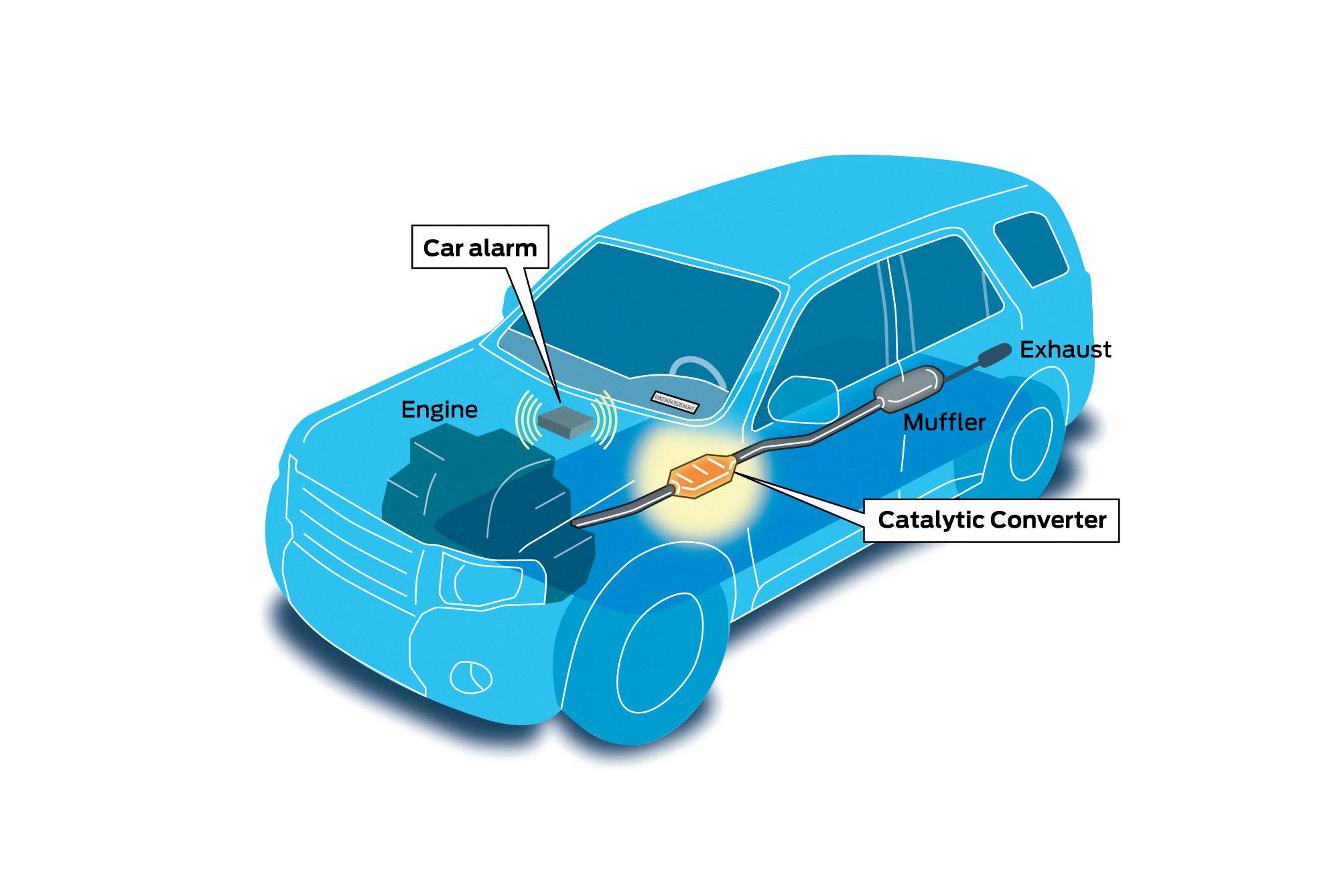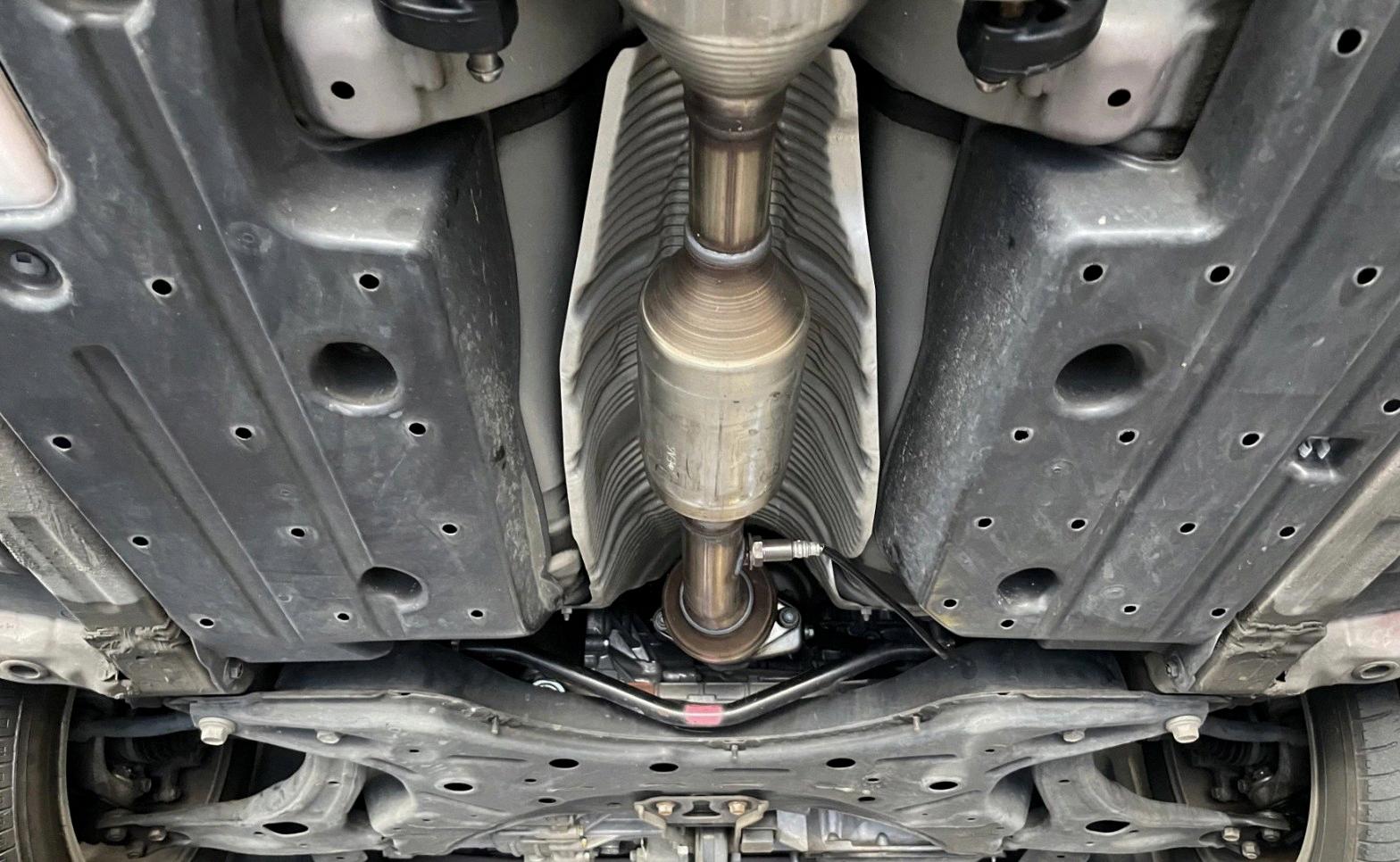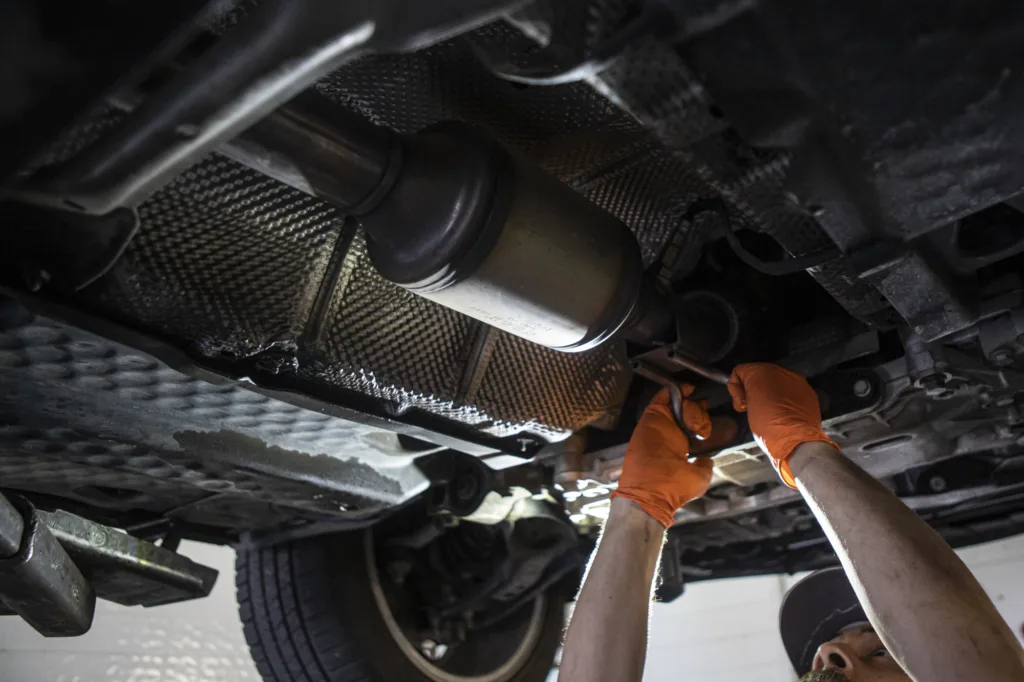Catalytic converters are an essential component of the exhaust system in modern cars. They play a vital role in reducing harmful emissions and are a key part of environmental protection efforts. But, do all cars have catalytic converters? Let’s find out!
Firstly, it’s important to understand what a catalytic converter is and how it works. This device is typically made up of a ceramic honeycomb coated with precious metals such as platinum, palladium, and rhodium. The honeycomb structure allows for a large surface area, whch helps to catalyze the chemical reactions that occur within the converter.
When exhaust gases pass through the converter, the precious metals react with the harmful pollutants in the exhaust, such as carbon monoxide, hydrocarbons, and nitrogen oxides. These reactions turn the pollutants into less harmful substances such as carbon dioxide, water vapor, and nitrogen gas, which are then released into the atmosphere.
Now, the answer to the question: do all cars have catalytic converters? The short answer is no, but the long answer is more complex. Since 1975, all new gasoline-powered cars sold in the United States have been required by federal law to have catalytic converters. Diesel-powered cars have also been required to have them since 2007.
However, not all countries have the same regulations. In some parts of the world, older cars and those manufactured without catalytic converters are still allowed on the roads. This means that if you travel to certain countries, you may come across cars that don’t have catalytic converters.
Additionally, some older cars and classic cars may not have catalytic converters because they were manufactured before the regulations were put in place. These cars are often exempt from modern emissions standards, but it’s important to note that they still contribute to air pollution and can be harmful to the environment.
Catalytic converters are an essential component of modern cars and play a vital role in reducing harmful emissions. While not all cars have catalytic converters, the vast majority of new cars sold in the United States and other countries are required to have them. It’s important to continue to support environmental protection efforts and encourage the use of clean energy to reduce the impact of transportation on the planet.
Cars That Do Not Have Catalytic Converters
The only vehicles that don’t have catalytic converters are all-electric vehicles. These vehicles do not use gasoline or diesel and instead rely solely on batteries that are recharged by plugging them in. However, all other vehicles, including non-plug-in hybrids, plug-in hybrids, and any hybrid that runs on gas or diesel, use catalytic converters. The catalytic converter is an essential part of a vehicle’s exhaust system as it helps reduce harmful emissions that are released into the environment. Its function is to convert toxic pollutants in the exhaust gases into less harmful substances before they are released into the air. Therefore, it is crucial for all vehicles to have a catalytic converter to reduce their impact on the environment.

Source: carfax.com
Identifying a Vehicle Without a Catalytic Converter
There are a few telltale signs that your car may not have a catalytic converter. The first and most obvious sign is a loud roaring noise coming from your exhaust system. This noise will get louder as you press down on the gas pedal.
Another sign that your car may not have a catalytic converter is a sputtering noise when you change speeds. This is caused by the lack of backpressure in the exhaust system, which can case the engine to run poorly.
In addition to these noises, you may also notice that your car is not driving smoothly. This is because the lack of a catalytic converter can cause your engine to run hotter, which can lead to poor performance and reduced fuel efficiency.
If you suspect that your car does not have a catalytic converter, it’s important to have it inspected by a qualified mechanic. Not only is driving without a catalytic converter illegal in many states, it can also be harmful to the environment and could cause damage to your engine in the long run.
Which Cars Are Least Likely to Have a Catalytic Converter Theft?
Catalytic converter thefts have been on the rise in recent years due to the precious metals used in their construction. However, certain types of vehicles are less likely to be targeted by thieves. Cars manufactured before 1974 are least likely to have their catalytic converters stolen because they do not cntain them. Diesel-powered vehicles are also less likely to be targeted due to the different technology used in their catalytic converters. Additionally, electric cars are impossible to steal catalytic converters from since they don’t have them. Among non-electric vehicles, Ford, Subaru, Hyundai, Chrysler, Chevrolet, Dodge, Mazda, and Nissan sedans (non-hybrids) are also considered less attractive targets for thieves due to the lower value of their catalytic converters.
Does Every Car Have a Catalytic Converter?
No, not every car has a catalytic converter installed. However, every new car manufactured since 1975 has been required by federal law to have a catalytic converter. So, any car made before 1975 is exempt from this requirement. Additionally, some older cars may have had their catalytic converters removed or replaced with aftermarket parts, whih can also result in the car no longer having a catalytic converter. However, it is important to note that removing or disabling a catalytic converter is illegal and can result in hefty fines and even imprisonment. So, if you own a car that was manufactured after 1975, it is required to have a catalytic converter installed and functioning properly.
Protecting Catalytic Converters from Theft
Catalytic converter theft has become a growing problem in recent years, but there are steps you can take to protect your vehicle. First, it’s important to know if you’re a target for theft. Thieves often target vehicles with larger engines, such as trucks and SUVs, as they have more valuable catalytic converters.
One effective way to prevent theft is to install an anti-theft device on your catalytic converter, such as a cage or clamp. These devices make it difficult for thieves to access and remove the converter. Alternatively, you can paint your catalytic converter with a high-temperature spray paint, which makes it less appealing to thieves as it becomes harder to sell.
Another option is to set an alarm or camera to catch thieves in the act. This can deter thieves from attempting to steal your converter, as they know they are more likely to get caught. Additionally, check your car insurance to see if theft of your catalytic converter is covered. If not, consider adding it to your policy or purchasing a separate theft protection plan.
In summary, protecting your catalytic converter from theft involves taking steps to make it less accessible and less valuable to potential thieves. By uing anti-theft devices, painting your converter, setting alarms or cameras, and checking your insurance coverage, you can significantly reduce the risk of theft and protect your vehicle.

Source: sfchronicle.com
The Year of Cars Being Targeted for Catalytic Converter Theft
According to a recent analysis of service records from over 60,000 service shops across the country, the cars that are most likely to be targeted for catalytic converter theft are tose manufactured between 1985 and 2021 in the case of Ford F-Series, between 1989 and 2020 in the case of Honda Accord, and between 2007 and 2017 in the case of Jeep Patriot. It’s important to note that while these vehicles are more likely to be targeted, catalytic converter theft can occur on any car, regardless of its age or make. It’s always a good idea to take precautions such as parking in well-lit areas or investing in a protective cover for your catalytic converter.
Driving Without a Catalytic Converter: Is It Safe?
While it is possible to drive a car without a catalytic converter, it is not recommended for several reasons. First and foremost, a catalytic converter is a critical component of a vehicle’s emission control system, whch is designed to reduce harmful pollutants in the exhaust gases. Without a catalytic converter, these pollutants are released into the atmosphere, contributing to air pollution and potentially harming the environment and public health.
In addition to the environmental impact, driving without a catalytic converter can also cause damage to your engine. The catalytic converter plays a crucial role in regulating the backpressure of your exhaust system, and without it, your engine may experience increased backpressure, which can cause overheating, misfires, and decreased performance.
Furthermore, driving without a catalytic converter may also result in legal issues. In many states and countries, it is illegal to operate a vehicle without a catalytic converter, and violating these laws can result in hefty fines and even impoundment of your vehicle.
In conclusion, while it may be possible to drive without a catalytic converter, it is not recommended for the reasons mentioned above. If your catalytic converter has been stolen or damaged, it is important to have it replaced as soon as possible to ensure the safe and efficient operation of your vehicle.
Does Insurance Cover Stolen Catalytic Converters?
Yes, if you have comprehensive coverage on your auto insurance policy, then a stolen catalytic converter is typically covered. Comprehensive coverage is designed to protect you aginst losses that are not caused by a collision, such as theft, vandalism, and natural disasters. In the case of a stolen catalytic converter, comprehensive coverage will typically pay to replace the stolen part and repair any damage that was caused during its removal. However, it’s important to note that not all policies offer comprehensive coverage, so you should check with your insurance company to see if you’re covered. Additionally, there may be limits to the amount of coverage provided, so you should review your policy carefully to understand your coverage limits and deductibles.
The Motives Behind Catalytic Converter Thefts
Thieves are stealing catalytic converters because of the valuable metals they contain, such as rhodium, palladium, and platinum. These metals can be sold for a high price on the black market, with rhodium currently gong for up to $20,000 per ounce. The increase in reported thefts of catalytic converters, which rose by 325% between 2019 and 2020, can be attributed to the high demand for these metals and the ease with which the converters can be removed from vehicles. As a result, car owners should take precautions, such as parking in well-lit areas and installing anti-theft devices, to prevent their catalytic converters from being stolen.

Source: inewsource.org
Popular Catalytic Converters to Steal
According to experts, the most commonly targeted vehicles for catalytic converter thefts are Honda Accords and Toyota Priuses. Criminals ofen target these specific vehicles because they contain a higher concentration of precious metals like rhodium, palladium, and platinum, which are valuable and can be sold for a good profit. Moreover, these metals are used in the production of catalytic converters, making them a lucrative target for thieves. Apart from this, criminals also target dimly lit areas without cameras to commit the thefts, making it easier for them to carry out the crime unnoticed. Therefore, if you own a Honda Accord or Toyota Prius, you may want to take extra precautions to protect your vehicle’s catalytic converter from being stolen.
Cars Least Likely to be Stolen
Cars that are equipped with advanced anti-theft technologies are the least liely to be stolen. Some of the most secure cars on the market include the BMW 3 Series, Tesla Model S, and Audi A4. These vehicles are equipped with features such as immobilizers, which prevent the engine from starting without the correct key, and keyless entry systems that use encrypted codes to prevent unauthorized access. In addition, many car manufacturers offer tracking systems that allow the car to be located if it is stolen. The use of these technologies has played a significant role in deterring thieves and lowering crime rates. It is important to note, however, that no car is completely immune to theft, and it is still important to take precautions such as locking doors and windows and parking in well-lit areas.
Estimated Value of Stolen Catalytic Converters
According to a 2021 report by the Congressional Research Service, a stolen catalytic converter can generate anwhere from $25 to $500. However, the cost to replace the stolen part can be quite high, with some estimates reaching up to $3,000. It’s important to note that the value of a stolen catalytic converter can vary depending on factors such as location, demand for the part, and the type of vehicle it was stolen from. Certain vehicles, such as the Ford F-Series, Honda Accords, and Toyota Priuses, are more commonly targeted for catalytic converter theft due to the high value of the precious metals contained within the part. It’s important for car owners to take precautions, such as parking in well-lit areas and installing a protective device, to reduce the risk of catalytic converter theft.

Conclusion
In conclusion, catalytic converters play a crucial role in reducing harmful emissions from gasoline- and diesel-powered vehicles. They have been a federally mandated requirement on all new vehicles since 1975, and their effectiveness in reducing pollution has only increased with advancements in technology. While the theft of catalytic converters has become a growing issue, especially for certain models, it is important to remember the important function they serve in protecting the environment and our health. As we continue to strive for a cleaner, more sustainable future, catalytic converters will undoubtedly remain an essential component of the automotive industry.
